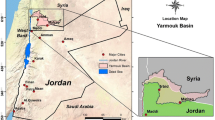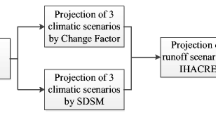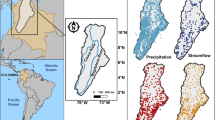Abstract
The future sensitivity of the surface water supply of Québec City is assessed in this paper using two methodologies: the methodology that has prevailed since the publication of the AR4 report, the hydroclimatological modeling framework, and an alternative approach adapted from Foulon et al. (2018). This alternative approach captures past relationships between climate data indices (CDIs), such as cumulative rainfall, and hydrological data indices (HDIs), such as 7-day low flows, and applies these relationships to assess future trends. Future climates were built for two emission scenarios, RCP-4.5 and − 8.5, and the uncertainty of climate change was addressed through the use of 16 climate models. Overall, both methodological frameworks predicted similar low flow trends for the reference and future horizons (2016–2045 and 2046–2075). The future pressure on the surface water supply of Québec City should raise concerns. Indeed, for RCP-8.5, results indicated a decrease in the PI1 values (ratio of 2-year low flow to water abstraction rate) of around 20% (2016–2045) and 35% (2046–2075) with a fairly high confidence (around 90% of models agreeing on the direction of change); leading to values less than 1; indicating an insufficient water supply with respect to available water during 2-year low flows. These results demonstrate the capacity of the method to provide a screening assessment of future drought-prone-watersheds. Furthermore, the application of the alternative approach, given climate simulations, would help early implementation of good management practices even for municipalities that do not have the capacities to conduct the more conventional approach.





Similar content being viewed by others
References
Bérubé J (2007) Evaluation d'un indice de pression sur les approvisionnements municipaux en eau potable au Québec à l'aide d'une méthode de régionalisation des débits d'étiage, Maîtrise, 101 pp. INRS, Québec
Beven K (2006) A manifesto for the equifinality thesis. J Hydrol 320:18–36. https://doi.org/10.1016/j.jhydrol.2005.07.007
Beven K, Freer J (2001) Equifinality, data assimilation, and uncertainty estimation in mechanistic modelling of complex environmental systems using the GLUE methodology. J Hydrol 249:11–29
Blanchette M, Rousseau A, Foulon E, Savary S, Poulin M (2018) Long-term assessment of the impact of land cover change on the hydrological services provided by wetlands. Environmental Management Under Review
Blöschl G, Montanari A (2010) Climate change impacts—throwing the dice? Hydrol Process 24:374–381. https://doi.org/10.1002/hyp.7574
Brodeur C, Brassard D, Dionne N, Laberge V, Labrecque R, Trépanier J, Turmel P (2012) Portrait des bassins versants de la Capitale, Organisme des bassins versants de la Capitale
Byun HR, Wilhite DA (1999) Objective quantification of drought severity and duration. J Clim 12:2747–2756
CEHQ (2015) Hydroclimatic Atlas of Southern Québec. The Impact of Climate Change on High, Low and Mean Flow Regimes for the 2050 horizon, 81 pp, Québec
COBAMIL (2014) Problèmes prioritaires, orientations et objectifs du PDE de la zone de gestion intégrée de l'eau par bassins versants du COBAMIL, 18 pp, Conseil des bassins versants des Mille-Îles. Sainte-Thérèse, Québec
Côté B, Leconte R, Trudel M (2013) Développement d'un prototype de système d'alerte aux faibles débits et aux prélèvements excessifs dans le bassin versant pilote de la rivière Yamaska, 111 pp, Université de Sherbrooke, Québec
Cunnane C (1978) Unbiased plotting positions — a review. J Hydrol 37:205–222. https://doi.org/10.1016/0022-1694(78)90017-3
Dobler C, Hagemann S, Wilby RL, Stötter J (2012) Quantifying different sources of uncertainty in hydrological projections in an Alpine watershed. Hydrol Earth Syst Sci 16:4343–4360. https://doi.org/10.5194/hess-16-4343-2012
Ehret U, Zehe E, Wulfmeyer V, Warrach-Sagi K, Liebert J (2012) HESS opinions “should we apply bias correction to global and regional climate model data?”. Hydrol Earth Syst Sci 16:3391–3404. https://doi.org/10.5194/hess-16-3391-2012
Environnement Canada (2012) The hydrometric network. https://www.canada.ca/en/environment-climate-change/services/water-overview/quantity/monitoring/survey/hydrometric-program-national-partnership/network.html. Accessed December, 12 2017
Fortin J-P, Turcotte R, Massicotte S, Moussa R, Fitzback J, Villeneuve J-P (2001) A distributed watershed model compatible with remote sensing and GIS data. Part I: Description of the model. J Hydrol Eng 6:91–99
Foulon E, Rousseau AN (2018) Equifinality and automatic calibration: what is the impact of hypothesizing an optimal parameter set on modelled hydrological processes? Can Water Resour J 43:47–67. https://doi.org/10.1080/07011784.2018.1430620
Foulon E, Rousseau AN, Gagnon P (2018) Development of a methodology to assess future trends in low flows at the watershed scale using solely climate data. Can Water Resour J 557:774–790. https://doi.org/10.1016/j.jhydrol.2017.12.064
Huard D (2010) Tributaires du St-Laurent - Documentation Release 0.2, 17 pp, Montréal, Québec
Hutchinson MF, McKenney DW, Lawrence K, Pedlar JH, Hopkinson RF, Milewska E, Papadopol P (2009) Development and testing of Canada-wide interpolated spatial models of daily minimum-maximum temperature and precipitation for 1961-2003. J Appl Meteorol Climatol 48:725–741
Institut de la statistique du Québec (2015) Profils statistiques par région et MRC géographiques. http://www.stat.gouv.qc.ca/statistiques/profils/region_00/region_00.htm. Accessed October 2017
IPCC (2007) Climate Change 2007: Synthesis report. Contribution of working groups I, II and III to the fourth assessment report of the intergovernmental panel on climate change, 104 pp. IPCC, Geneva
IPCC (2014) Climate Change 2014: Impacts, Adaptation and Vulnerability. Part A: Global and Sectoral Aspects. Contribution of Working Group II to the Fifth Assessment Report of the Intergovernmental Panel on Climate Change, 1132 pp, Cambridge, United Kingdom and New York, NY, USA
Koenker R (2005) Quantile regression, 1–368 pp., Cambridge University Press, United Kingdom
Kundzewicz ZW et al (2007) Freshwater resources and their management. In: Parry ML, Canziani OF, Palutikof JP, van der Linden PJ, Hanson CE (eds) Climate change 2007: Impacts, Adaptation and Vulnerability. Contribution of Working Group II to the Fourth Assessment Report of the Intergovernmental Panel on Climate Change. Cambridge University Press, Cambridge, pp 173–210
Mann HB, Whitney DR (1947) On a test of whether one of two random variables is stochastically larger than the other. Ann Math Stat 18:50–60. https://doi.org/10.1214/aoms/1177730491
MDDELCC (2016) Bilan de la qualité de l’eau potable au Québec 2010–2014. http://www.mddelcc.gouv.qc.ca/eau/potable/bilans/bilan-qualite2010-2014.pdf. Accessed October 2017
MDDEP (2007) Calcul et interprétation des objectifs environnementaux de rejet pour les contaminants en milieu aquatique. Québec, ministère du Développement durable, de l’Environnement et des Parcs, Direction du suivi de l’état de l’environnement,. http://www.mddelcc.gouv.qc.ca/eau/oer/Calcul_interpretation_OER.pdf. Accessed Octobre 2017
Moriasi DN, Arnold JG, VanLiew MW, Bingner RL, Harmel RD, Veith TL (2007) Model evaluation guidelines for systematic quantification of accuracy in watershed simulations. Trans ASABE 50:885–900
Mpelasoka FS, Chiew FHS (2009) Influence of rainfall scenario construction methods on runoff projections. J Hydrometeorol 10:1168–1183. https://doi.org/10.1175/2009JHM1045.1
Nantel E (2006), Elaboration d'une méthode d'estimation des vulnérabilités historiques des approvisionnements en eau potable au Québec, Maîtrise, 134 pp, INRS, Québec
Ouranos (2016) Bilan hydrologique des rivières Saint-Charles et Montmorency dans un contexte de changements climatiques, Rapport présenté à la Communauté métropolitaine de Québec, 44 + annexes pp. Canada
Riahi K et al (2011) RCP 8.5—a scenario of comparatively high greenhouse gas emissions. Clim Chang 109:33. https://doi.org/10.1007/s10584-011-0149-y
Ricard S, Bourdillon R, Roussel D, Turcotte R (2013) Global calibration of distributed hydrological models for large-scale applications. J Hydrol Eng 18:719–721
Salou BIG (2009) Estimation des apport au lac Saint-Charles à l'aide du modèle hydrologique SWAT, 64 pp, Université Laval, Québec, Canada.
Smakhtin VU (2001) Low flow hydrology: a review. J Hydrol 240:147–186. https://doi.org/10.1016/S0022-1694(00)00340-1
Staudinger M, Stahl K, Seibert J, Clark MP, Tallaksen LM (2011) Comparison of hydrological model structures based on recession and low flow simulations. Hydrol Earth Syst Sci 15:3447–3459. https://doi.org/10.5194/hess-15-3447-2011
Teng J, Vaze J, Chiew FHS, Wang B, Perraud J-M (2012) Estimating the relative uncertainties sourced from GCMs and hydrological models in modeling climate change impact on runoff. J Hydrometeorol 13:122–139. https://doi.org/10.1175/jhm-d-11-058.1
Thomson AM, Calvin KV, Smith SJ, Kyle GP, Volke A, Patel P, Delgado-Arias S, Bond-Lamberty B, Wise MA, Clarke LE, Edmonds JA (2011) RCP4.5: a pathway for stabilization of radiative forcing by 2100. Clim Chang 109:77–94. https://doi.org/10.1007/s10584-011-0151-4
Todd MC, Taylor RG, Osborn TJ, Kingston DG, Arnell NW, Gosling SN (2011) Uncertainty in climate change impacts on basin-scale freshwater resources – preface to the special issue: the QUEST-GSI methodology and synthesis of results. Hydrol Earth Syst Sci 15:1035–1046. https://doi.org/10.5194/hess-15-1035-2011
Tolson BA, Shoemaker CA (2007) Dynamically dimensioned search algorithm for computationally efficient watershed model calibration, Water Resour. Res., 43, W01413, https://doi.org/10.1029/2005WR004723
Tolson BA, Shoemaker CA (2008) Efficient prediction uncertainty approximation in the calibration of environmental simulation models, Water Resour. Res., 44, W04411, https://doi.org/10.1029/2007WR005869
Turcotte R, Rousseau AN, Fortin J-P, Villeneuve J-P (2003) Development of a process-oriented, multiple-objective, hydrological calibration strategy accounting for model structure. In: Duan Q, Sorooshian S, Gupta H, Rousseau AN, Turcotte R (eds) Advances in calibration of watershed models. Water Science & Application, vol no. 6. American Geophysical Union (AGU), Washinghton, pp 153–163
Turcotte R, Fortin LG, Fortin V, Fortin JP, Villeneuve JP (2007) Operational analysis of the spatial distribution and the temporal evolution of the snowpack water equivalent in southern Québec, Canada. Nord Hydrol 38:211–234. https://doi.org/10.2166/nh.2007.009
Acknowledgements
The authors would like to thank Marco Braun of Ouranos for his scientific support and Ouranos for providing the climate simulation data. We thank Québec City for providing the water intake flow data at a 3-h time step between 2006 and 2013. We also thank Stéphane Savary and Sébastien Tremblay of INRS (Centre Eau Terre Environnement) for their respective insights and computer support throughout the project. Financial support for this project was provided by the Natural Sciences and Engineering Research Council (NSERC) of Canada through the Discovery Grant Program (A.N. Rousseau, principal investigator).
Author information
Authors and Affiliations
Corresponding author
Ethics declarations
Conflict of Interest
None
Additional information
The highlights for the paper are the following:
• Foulon et al. (2018)’s methodology can provide a screening assessment of future drought prone watersheds
• Assessment for RCP-4.5 and -8.5 of the low flow trends for the main water intake of Québec City
• Assessment for RCP-4.5 and -8.5 of the future pressure on water ressources for Québec City
• Testing of a methodology that may enable good water management practices for small municipalities
Electronic supplementary material
Online Resource 1
(DOCX 19 kb)
Online Resource 2
(DOCX 243 kb)
Online Resource 3
(DOCX 104 kb)
Online Resource 4
(DOCX 182 kb)
Rights and permissions
About this article
Cite this article
Foulon, É., Rousseau, A.N. Surface Water Quantity for Drinking Water during Low Flows - Sensitivity Assessment Solely from Climate Data. Water Resour Manage 33, 369–385 (2019). https://doi.org/10.1007/s11269-018-2107-1
Received:
Accepted:
Published:
Issue Date:
DOI: https://doi.org/10.1007/s11269-018-2107-1




